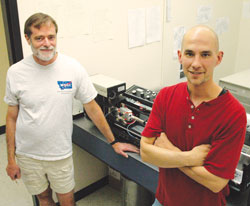University Communications and Marketing
Undergraduate math/physics wiz gets dream summer job at MSU Billings
July 13, 2009
Contacts:
Dan Carter, University Relations, 657-2269
Senior gets to rebuild laser used by faculty mentor Dr. Stuart Snyder
MSU BILLINGS NEWS SERVICES — When the “what I did this summer” conversations start up in September, Steven Shoen should be able to leave anyone speechless. After all, few can top rebuilding a neodymium-doped yttrium aluminum garnet laser.
Pretty cool, huh?
 And that doesn’t even include recent news that Schoen will receive a major scholarship
from the Montana Space Grant Consortium for the 2009-1010 academic year.
And that doesn’t even include recent news that Schoen will receive a major scholarship
from the Montana Space Grant Consortium for the 2009-1010 academic year.
Shoen, a Montana State University Billings math major who is minoring in physics, is working this summer rebuilding a solid state laser that was phased out of research duty at the Idaho National Laboratory in Idaho Falls. It happens to be the same laser that one of his faculty mentors — Dr. Stuart Snyder — used when he was doing energy research at INL.
“They called and asked if I wanted it,” said Snyder of the laser he estimates is worth over $50,000. “We basically got a laser for free.”
And because of that, Snyder notes, MSU Billings continues to develop a top-notch undergraduate physics lab.
That fact is not lost on Shoen, whose electrical and mechanical prowess is being used to piece the Nd:YAG laser together after it was essentially dismantled in Idaho. With the expert leadership of Becky Jordan, a chemistry major from Billings, they spent much of May and June connecting wires.
Shoen then worked on checking systems and making sure all the parts were in place. He was already doing work as a lab assistant for Snyder this summer and saw the laser work as a bonus.
“I started here (at MSU Billings) with other goals, but got shifted toward physics,” he said. “I feel real fortunate because of the timing of getting the laser here. What a great opportunity.”
Shoen is one of 16 college students to receive the Montana Space Grant Scholarships this year. He will use his $1,500 scholarship to pursue his minor and continue his study of physics. Because he is one of only two physics minors at MSU Billings, he will have his own laser with which to do experiments.
Snyder said the laser, which is so intense when at full pulse that it “actually rips air apart” will be used by Shoen and other undergraduate science students to study various properties of light and energy. Across the hall is another laser (just a few years old) which students also use in laser spectroscopy studies.
“Science students interested in this stuff now have opportunities that never existed here before,” he said.
Montana Space Grant Consortium Interim Director Angela Des Jardins, in a letter to Shoen on his scholarship award, noted Snyder’s commitment to students.
“The continued success of the Montana Space Grant Scholarship program at MSU Billings is due to the ongoing efforts and commitment of our representative at MSU Billings, Stuart Snyder,” she wrote.
The Montana Space Grant Consortium was established in 1991 as a component of NASA’s National Space Grant College and Fellowship Program. The Montana program is one of a national network of 52 consortia which work to strengthen aerospace research and education. Members of the Montana Space Grant Consortium consist of institutions of higher education, business, industry and non-profit organizations.
Snyder established the first MSU Billings research program in experimental physics. His research, as part of the Montana Platinum Research Initiative, uses a new high-powered state-of-the-art laser spectroscopy laboratory to study platinum group elements.
He also teaches a popular “Earth, Air, Fire and Water” class for non-science majors that provides students with an understanding of everyday physics.
The Department of Biological and Physical Sciences at MSU Billings is an interdisciplinary department, which means faculty members don't divide themselves into several separate science departments with each having their own priorities. The department is one in which biologists, chemists, physicists and earth scientists all work together to design and administer the best possible academic programs for students that fit well within their majors.
For more information on the sciences at MSU Billings, go to www.msubillings.edu/cas/sciences. For more information on the Montana Space Grant Consortium, go to www.spacegrant.montana.edu.
PHOTO AT LEFT: Steve Shoen (right) and Dr. Stuart Snyder with an neodymium-doped yttrium aluminum garnet (Nd:YAG) laser. Shoen is spending the summer doing work rebuilding the laser.
